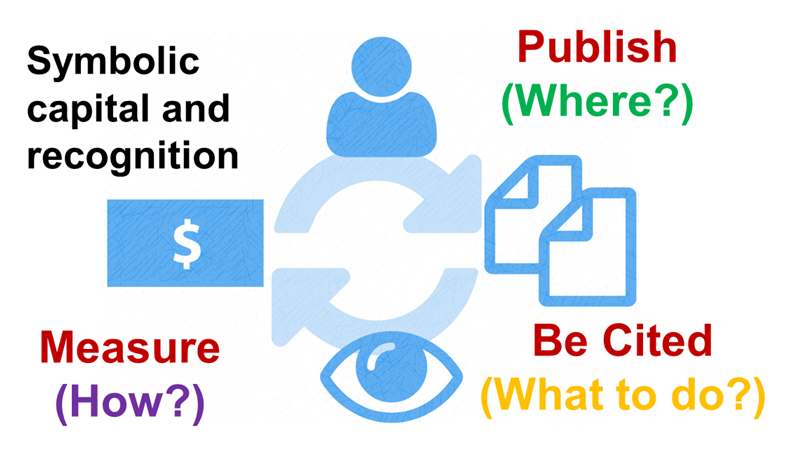Social Sciences
Source: http://substance-en.etsmtl.ca/10-tips-for-increasing-the-visibility-of-your-publications/
 Scientific
Scientific
output indicators that are calculated based on a researcher?s number of
published papers and the number of times these articles are cited can
have a major impact on many aspects of a researcher?s career. These
indicators are taken into account when establishing world rankings,
allocating research grants, determining whether the researcher will be
promoted within his or her institution, and even by students examining
their graduate school options. Thus, publishing scientific papers goes
farther than just sharing research findings, it also helps researchers
gain recognition.1. Consider scientific collaboration
2. Publish in indexed journals
3. Suggest that a journal be added to Web of Science and Scopus
4. Publish in open access journals
 Open access journals tend to be offered exclusively online and publication fees can be quite high. But this is golden road to open access,
Open access journals tend to be offered exclusively online and publication fees can be quite high. But this is golden road to open access,
as the editor ensures that papers are available to all. This
?author-payer? model is used by several prestigious magazines as well as
some profit-driven publications that are not always considered credible
(for more on this topic, see this list of predatory publishers).
5. Keep the pre-print and post-print versions of accepted articles
6. Deposit your papers in institutional repositories
8. List your publications in an online profile
9. Connect with influential researchers on scientific social media
10. Share your research on social media
 Held Barbosa de Souza
Held Barbosa de Souza
is a librarian at École de technologie supérieure (ÉTS). She holds a
master?s degree in Information Sciences from Université de Montréal, and
her thesis paper was on bibliometrics and the contribution of Canadian
post-doctoral fellows to the advancement of knowledge.
 Adèle Paul-Hus
Adèle Paul-Hus
is a reference librarian at ÉTS and PhD candidate in Information
Sciences at the Library and Information Science School of Université de
Montréal. Her doctoral research focuses on the function of credits in
the scholarly communication proces
10 Tips for Increasing the Visibility of Your Publications - Substance ÉTSSubstance ÉTS
- Promoting Research
Source: http://www.swansea.ac.uk/iss/researchsupport/promoting%20research/ Get your research noticedSome ideas to tryUniversities are increasingly ranked by their research so promoting it is important. Citation count is one measurement...
- Exposing Your Research - James Hardiman Library - Nui Galway
Source: http://www.library.nuigalway.ie/researchsupport/publishingyourresearch/exposingyourresearch/ Exposing your ResearchThe visibility and exposure of your research is influenced by many factors. Selecting where to publish is one of the...
- How To Maximize Impact And Visibility In Bibliometric Analysis: Tips - Tampere University Of Technology
Source: http://www.tut.fi/en/library/research-support-services/publishing/maximize-impact-and-visibility/index.htm How to maximize impact and visibility in bibliometric analysis: tipsThe content and quality of the publication are essential in assessing...
- Maximizing The Visibility And Impact Of Your Published Research
Source: http://www.concordia.ca/library/guides/accountancy/impact.html Maximizing the visibility and impact of your published research Measuring the inter-and cross-disciplinary impact of your published research can be a valuable indication of...
- Maximizing The Visibility And Impact Of Your Published Research
Source: https://library.concordia.ca/research/subjects/accountancy/impact.php Maximizing the Visibility and Impact of Your Published Research Introduction Measuring the inter-and cross-disciplinary impact of your published research can be a valuable...
Social Sciences
10 Tips for Increasing the Visibility of Your Publications - Substance ÉTSSubstance ÉTS
Source: http://substance-en.etsmtl.ca/10-tips-for-increasing-the-visibility-of-your-publications/
10 Tips for Increasing the Visibility of Your Publications
1 Apr 2015
By Held Barbosa de Souza and Adèle Paul-Hus
By Held Barbosa de Souza and Adèle Paul-Hus
0
Do you know how to improve
your paper?s chances of being cited? Here are 10 handy tips that every
researcher should know on how to get your work noticed.
your paper?s chances of being cited? Here are 10 handy tips that every
researcher should know on how to get your work noticed.
 Scientific
Scientificoutput indicators that are calculated based on a researcher?s number of
published papers and the number of times these articles are cited can
have a major impact on many aspects of a researcher?s career. These
indicators are taken into account when establishing world rankings,
allocating research grants, determining whether the researcher will be
promoted within his or her institution, and even by students examining
their graduate school options. Thus, publishing scientific papers goes
farther than just sharing research findings, it also helps researchers
gain recognition.
The current research assessment context
puts a lot of pressure on researchers to publish papers. However,
research assessment experts have made it clear that indicators based on
the number of times a paper is cited are much more important than those
based on the number of articles published (ACUMEN 2010, p. 14). There
are strategies that can help you get your research noticed?and even
cited. Here are a few:
puts a lot of pressure on researchers to publish papers. However,
research assessment experts have made it clear that indicators based on
the number of times a paper is cited are much more important than those
based on the number of articles published (ACUMEN 2010, p. 14). There
are strategies that can help you get your research noticed?and even
cited. Here are a few:
1. Consider scientific collaboration
Studies show that articles published in
collaboration tend to be quoted more frequently (see, for example, the
2014 Larivière study). In general, inter-institutional, inter-sectorial
and international collaborations can help boost an article?s impact.
collaboration tend to be quoted more frequently (see, for example, the
2014 Larivière study). In general, inter-institutional, inter-sectorial
and international collaborations can help boost an article?s impact.
2. Publish in indexed journals
Indexed journals are those included in the Web of Science (WoS) and Scopus databases. Due to their rigorous selection criteria and data processing, these databases are considered reliable sources of bibliometrics.
They analyze the most widely known scientific reviews in all
disciplines. And since they index the references of each article, they
can compile indicators based on citations. In fact, these databases are
the best sources of these indicators.
They analyze the most widely known scientific reviews in all
disciplines. And since they index the references of each article, they
can compile indicators based on citations. In fact, these databases are
the best sources of these indicators.
3. Suggest that a journal be added to Web of Science and Scopus
Have you published a paper in a journal
that isn?t indexed in WoS or Scopus? Why not recommend that it be added!
WoS and Scopus are not exhaustive and index new journals every year.
These databases are generally open to suggestions concerning the
addition of journals to their corpuses, provided that these journals
meet their eligibility criteria. For more information, check the WoS and Scopus policies.
that isn?t indexed in WoS or Scopus? Why not recommend that it be added!
WoS and Scopus are not exhaustive and index new journals every year.
These databases are generally open to suggestions concerning the
addition of journals to their corpuses, provided that these journals
meet their eligibility criteria. For more information, check the WoS and Scopus policies.
4. Publish in open access journals
 Open access journals tend to be offered exclusively online and publication fees can be quite high. But this is golden road to open access,
Open access journals tend to be offered exclusively online and publication fees can be quite high. But this is golden road to open access,as the editor ensures that papers are available to all. This
?author-payer? model is used by several prestigious magazines as well as
some profit-driven publications that are not always considered credible
(for more on this topic, see this list of predatory publishers).
To view a directory of golden road to open access journals, click here

However, several journals have adopted a
distribution model that allows authors to self-archive their papers on a
website or institutional repository. This is what is referred to as the
green road to open access. At ÉTS, our institutional repository is called Espace ÉTS.
This route offers a significant advantage to authors, as no publication
fee is required. It?s also advantageous to readers, as access to papers
is free of charge and articles are easy to find using search engines.
Most journals found in WoS and Scopus allow articles to be
self-archived?just check with the publisher?s policy.
distribution model that allows authors to self-archive their papers on a
website or institutional repository. This is what is referred to as the
green road to open access. At ÉTS, our institutional repository is called Espace ÉTS.
This route offers a significant advantage to authors, as no publication
fee is required. It?s also advantageous to readers, as access to papers
is free of charge and articles are easy to find using search engines.
Most journals found in WoS and Scopus allow articles to be
self-archived?just check with the publisher?s policy.
To view a directory of green road to open access journals, click here:

5. Keep the pre-print and post-print versions of accepted articles
Green road to open access journals have
their own self-archiving policies. Green journals generally allow you to
submit the post-print version (the final version prior to being laid
out by the publisher). However, some journals only allow you to submit
the pre-print version, which is the version that precedes the peer
review. This information is available on the publisher?s website or in
the Sherpa/Romeo directory.
their own self-archiving policies. Green journals generally allow you to
submit the post-print version (the final version prior to being laid
out by the publisher). However, some journals only allow you to submit
the pre-print version, which is the version that precedes the peer
review. This information is available on the publisher?s website or in
the Sherpa/Romeo directory.
6. Deposit your papers in institutional repositories
By choosing a journal that allows
self-archiving and by saving the right version of your document, you
have everything you need to deposit your article in your institution?s
repository. There are major advantages, including: contributing to the
access-to-knowledge movement, promoting the conservation of information
and increasing your article?s visibility on the Web. Since institutional
repositories are developed using platforms that are easily indexed by
Google, your article will be easy to find.
self-archiving and by saving the right version of your document, you
have everything you need to deposit your article in your institution?s
repository. There are major advantages, including: contributing to the
access-to-knowledge movement, promoting the conservation of information
and increasing your article?s visibility on the Web. Since institutional
repositories are developed using platforms that are easily indexed by
Google, your article will be easy to find.
| Studies show that open access papers tend to be cited more often than non-open access papers (Gargouri et al., 2010). |
In general, institutional repositories
are managed in libraries by specialized librarians who can advise you on
self-archiving policies.
are managed in libraries by specialized librarians who can advise you on
self-archiving policies.
7. Popularize your research and scientific papers
If you want your research to catch the
attention of a broad audience and become widely known, it may be a good
idea to make the language more accessible, as in popular science
writing. There is an increasing number of platforms for publishing
popular science articles, including ÉTS?s Substance
scientific news website. This platform showcases the scientific
research conducted at ÉTS and, since it?s published in French and
English, it can help you reach a wide range of readers.
attention of a broad audience and become widely known, it may be a good
idea to make the language more accessible, as in popular science
writing. There is an increasing number of platforms for publishing
popular science articles, including ÉTS?s Substance
scientific news website. This platform showcases the scientific
research conducted at ÉTS and, since it?s published in French and
English, it can help you reach a wide range of readers.
8. List your publications in an online profile
Today, there are numerous online tools
that allow you to create individual publication profiles. Each of these
tools has unique capabilities, but all have the same objective: to share
research findings and increase the visibility of papers. A 2014 Van
Noorden study indicated that Google Scholar and Research Gate
are the tools that researchers are most likely to use on a regular
basis. The study also mentions that the scientific community also
frequently uses LinkedIn.
that allow you to create individual publication profiles. Each of these
tools has unique capabilities, but all have the same objective: to share
research findings and increase the visibility of papers. A 2014 Van
Noorden study indicated that Google Scholar and Research Gate
are the tools that researchers are most likely to use on a regular
basis. The study also mentions that the scientific community also
frequently uses LinkedIn.
9. Connect with influential researchers on scientific social media
This is a great way to keep up with
developments in a given research field. Follow the most well-known
researchers and research groups, and then participate in discussions:
this is an excellent networking strategy. This is particularly relevant
for purely scientific social media networks, such as Research Gate and Academia.edu.
developments in a given research field. Follow the most well-known
researchers and research groups, and then participate in discussions:
this is an excellent networking strategy. This is particularly relevant
for purely scientific social media networks, such as Research Gate and Academia.edu.
10. Share your research on social media
Social media like Twitter and Facebook
are used by researchers to post their articles. This can be effective as
a complementary strategy, as readers can easily share the information
with others. Interesting discussions can ensue, increasing the research
paper?s visibility.
are used by researchers to post their articles. This can be effective as
a complementary strategy, as readers can easily share the information
with others. Interesting discussions can ensue, increasing the research
paper?s visibility.
The tips listed here are not exhaustive,
nor are they essential for ensuring a research paper?s success. It?s up
to researchers to determine which methods are most relevant, taking
into consideration where they are at in their careers and the culture in
their fields.
nor are they essential for ensuring a research paper?s success. It?s up
to researchers to determine which methods are most relevant, taking
into consideration where they are at in their careers and the culture in
their fields.
For more information on any of these
points, or to monitor the progressive impact of your publications, talk
to a librarian at your institution. At ÉTS, librarians Held Barbosa de
Souza and Denis Levasseur are available to advise you on these topics.
points, or to monitor the progressive impact of your publications, talk
to a librarian at your institution. At ÉTS, librarians Held Barbosa de
Souza and Denis Levasseur are available to advise you on these topics.
Author
 Held Barbosa de Souza
Held Barbosa de Souzais a librarian at École de technologie supérieure (ÉTS). She holds a
master?s degree in Information Sciences from Université de Montréal, and
her thesis paper was on bibliometrics and the contribution of Canadian
post-doctoral fellows to the advancement of knowledge.
 Adèle Paul-Hus
Adèle Paul-Husis a reference librarian at ÉTS and PhD candidate in Information
Sciences at the Library and Information Science School of Université de
Montréal. Her doctoral research focuses on the function of credits in
the scholarly communication proces
10 Tips for Increasing the Visibility of Your Publications - Substance ÉTSSubstance ÉTS
- Promoting Research
Source: http://www.swansea.ac.uk/iss/researchsupport/promoting%20research/ Get your research noticedSome ideas to tryUniversities are increasingly ranked by their research so promoting it is important. Citation count is one measurement...
- Exposing Your Research - James Hardiman Library - Nui Galway
Source: http://www.library.nuigalway.ie/researchsupport/publishingyourresearch/exposingyourresearch/ Exposing your ResearchThe visibility and exposure of your research is influenced by many factors. Selecting where to publish is one of the...
- How To Maximize Impact And Visibility In Bibliometric Analysis: Tips - Tampere University Of Technology
Source: http://www.tut.fi/en/library/research-support-services/publishing/maximize-impact-and-visibility/index.htm How to maximize impact and visibility in bibliometric analysis: tipsThe content and quality of the publication are essential in assessing...
- Maximizing The Visibility And Impact Of Your Published Research
Source: http://www.concordia.ca/library/guides/accountancy/impact.html Maximizing the visibility and impact of your published research Measuring the inter-and cross-disciplinary impact of your published research can be a valuable indication of...
- Maximizing The Visibility And Impact Of Your Published Research
Source: https://library.concordia.ca/research/subjects/accountancy/impact.php Maximizing the Visibility and Impact of Your Published Research Introduction Measuring the inter-and cross-disciplinary impact of your published research can be a valuable...
